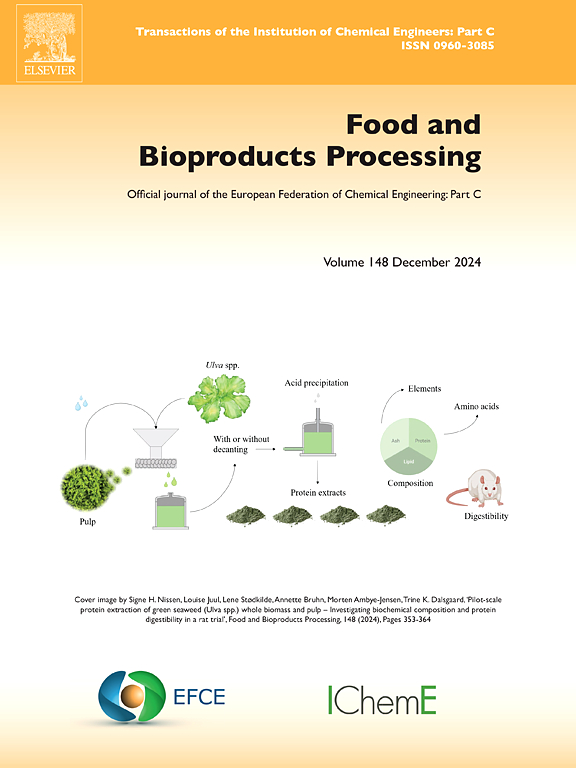使用天然化合物的可持续食品包装:当前研究进展综述
IF 3.5
2区 农林科学
Q2 BIOTECHNOLOGY & APPLIED MICROBIOLOGY
引用次数: 0
摘要
由于传统包装材料,特别是塑料的负面影响,食品包装行业面临着重大挑战。这些材料造成污染,降解缓慢,并通过化学浸出对人类健康和环境构成风险。因此,对更安全和更可持续的包装替代品的需求不断增加。天然化合物,包括生物聚合物和生物活性物质,提供了可生物降解的选择,减轻了这些风险。本文综述了用于环保包装的各种天然材料,如精油、植物提取物、多糖、蛋白质、脂类、壳聚糖、纤维素和淀粉。这篇综述强调了最近的创新,包括先进的生物聚合物配方、混合材料和基于纳米技术的增强,它们提高了天然包装解决方案的机械、抗菌和抗氧化性能。它还介绍了这些材料的比较分析,解决生物降解率,生命周期评估(lca),以及它们相对于传统塑料的环境效益。该综述进一步研究了与可扩展性、成本效益和监管障碍相关的挑战,同时也讨论了用于优化材料的机器学习等新兴技术。研究结果提供了可操作的见解,促进旨在解决全球健康和环境问题的可持续食品包装解决方案。本文章由计算机程序翻译,如有差异,请以英文原文为准。
Towards sustainable food packaging using natural compounds: A review of current research update
The food packaging industry faces significant challenges due to the negative impacts of conventional packaging materials, particularly plastics. These materials contribute to pollution, degrade slowly, and pose risks to both human health and the environment through chemical leaching. Consequently, there is an increasing demand for safer and more sustainable packaging alternatives. Natural compounds, including biopolymers and bioactive substances, provide biodegradable options that mitigate these risks. This review examines various natural materials used for environmentally friendly packaging, such as essential oils, plant extracts, polysaccharides, proteins, lipids, chitosan, cellulose, and starch. This review highlights recent innovations, including advanced biopolymer formulations, hybrid materials, and nanotechnology-based enhancements, which improve the mechanical, antimicrobial, and antioxidant properties of natural packaging solutions. It also presents comparative analyses of these materials, addressing biodegradation rates, life-cycle assessments (LCAs), and their environmental benefits relative to traditional plastics. The review further investigates challenges related to scalability, cost-effectiveness, and regulatory barriers, while also discussing emerging technologies such as machine learning for optimizing materials. The findings offer actionable insights that promote sustainable food packaging solutions aimed at addressing global health and environmental concerns.
求助全文
通过发布文献求助,成功后即可免费获取论文全文。
去求助
来源期刊

Food and Bioproducts Processing
工程技术-工程:化工
CiteScore
9.70
自引率
4.30%
发文量
115
审稿时长
24 days
期刊介绍:
Official Journal of the European Federation of Chemical Engineering:
Part C
FBP aims to be the principal international journal for publication of high quality, original papers in the branches of engineering and science dedicated to the safe processing of biological products. It is the only journal to exploit the synergy between biotechnology, bioprocessing and food engineering.
Papers showing how research results can be used in engineering design, and accounts of experimental or theoretical research work bringing new perspectives to established principles, highlighting unsolved problems or indicating directions for future research, are particularly welcome. Contributions that deal with new developments in equipment or processes and that can be given quantitative expression are encouraged. The journal is especially interested in papers that extend the boundaries of food and bioproducts processing.
The journal has a strong emphasis on the interface between engineering and food or bioproducts. Papers that are not likely to be published are those:
• Primarily concerned with food formulation
• That use experimental design techniques to obtain response surfaces but gain little insight from them
• That are empirical and ignore established mechanistic models, e.g., empirical drying curves
• That are primarily concerned about sensory evaluation and colour
• Concern the extraction, encapsulation and/or antioxidant activity of a specific biological material without providing insight that could be applied to a similar but different material,
• Containing only chemical analyses of biological materials.
 求助内容:
求助内容: 应助结果提醒方式:
应助结果提醒方式:


